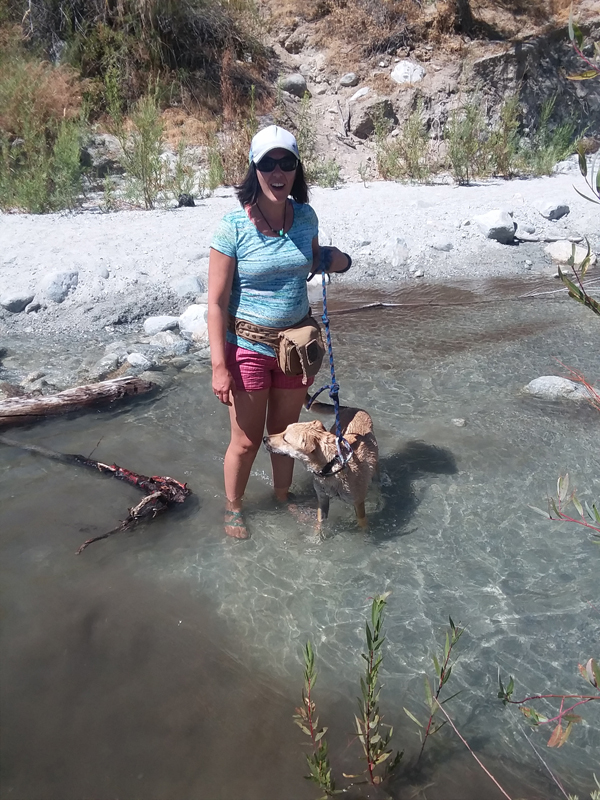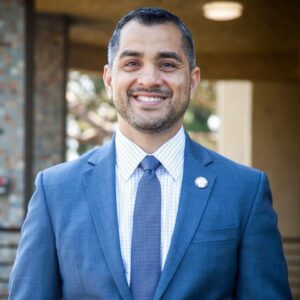A Historic Opportunity to Protect the Future of the California Desert
3 min read
Yanina and her dog at Whitewater Preserve in the Coachella Valley.
By Yanina Aldao Galvan, an ecologist and a member of the California Desert Coalition. She lives in Yucca Valley.
I fell in love with the California Desert nearly a decade ago while hiking the Pacific Crest Trail. It was late spring when I started the trail, which begins near the Mexico border and then passes through the Sonoran and Mojave deserts. On a particularly hot day, I arrived at a beautiful river at Whitewater Preserve—protected lands in the Coachella Valley. It was the first time I had seen a source of natural, running water since I began my hike weeks earlier, and I immediately jumped in. The water was cold and refreshing and I felt speechless with gratitude for nature.
That experience inspired me to move to the California Desert once I finished the Pacific Crest Trail. Since moving here I’ve hiked the entire Mojave Desert by foot! I love the California Desert for its wide open skies, its mountains, and incredible biodiversity. But every year climate change and other threats continue to put the things I love most about the Desert more at risk. We need to invest in protecting this region, so that future generations can be inspired by and enjoy the Desert, too.
Assemblymember James Ramos, who represents portions of the Inland Empire including San Bernardino, Redlands, and Rancho Cucamonga, recognized these threats and, along with local leaders, organizations, and community members, worked to create a new Desert Conservation Program within California’s Wildlife Conservation Board. This program is intended to provide new state funding opportunities to the California Desert, and it was recently signed into law.
While the establishment of the Desert Conservation Program was an important first step, it still requires funding. Our state leadership should ensure full funding for this program to provide much-needed conservation investments for California Desert’s people and places.
One of the most important priorities for the state should be protecting California Deserts’ ability to sequester carbon. Many people don’t know that Desert lands are covered by an incredible organism called biological soil crust (or biocrust) that captures and stores carbon from the atmosphere, allowing the Desert to capture a good portion of our state’s total carbon emissions. This is only possible when Desert soils remain undisturbed and undeveloped. I urge our state’s leaders to prioritize protecting California Desert lands from development so that the region can continue playing a key role in addressing climate change.
I also ask our leaders to prioritize funding for critical wildlife corridors so that we can help prevent further habitat fragmentation. There are many endangered species in the California Desert who need to roam freely across the landscape in order to find food, water, shelter, and mates. But obstacles like roads and freeways fragment habitats and make it harder for species to travel. For example, the federally-threatened desert tortoise has lived in the California Desert for millions of years, but is now facing the threat of extinction because we’ve disturbed so much of its habitat. We should invest in protecting more wildlife corridors so that desert tortoises and other species have the best chances of survival.
Finally, the state should fund programs that connect more people to the California Desert. There are many organizations that work to bring kids and adults to experience the magic of our region – to stargaze, see stunning views, or learn more about rare animals and plants. We should increase funding to these programs and help create new ones so that more locals, regardless of their socioeconomic status or where they live, can build their own connections to our Desert lands.
Thanks to the many leaders and community members who played a part in creating the new state Desert Conservation Program. Now we need to complete this effort by sufficiently funding it. This way, we can carry out all the important conservation projects that will ensure our region can thrive and remain resilient long into the future.
*Guest op-eds do not necessarily reflect the views of IECN.








